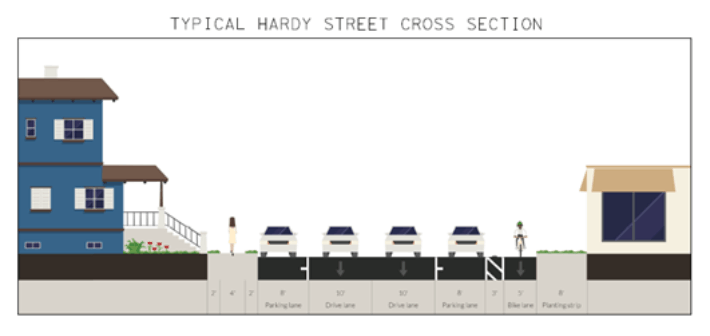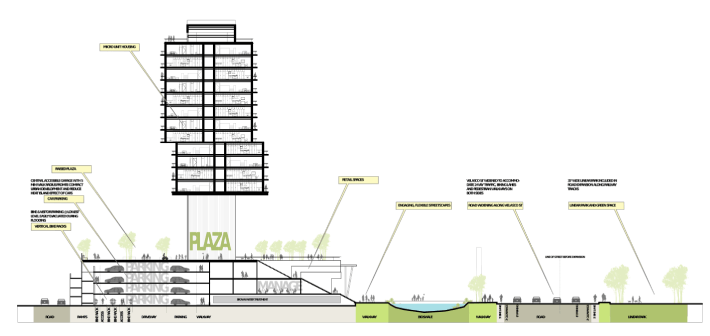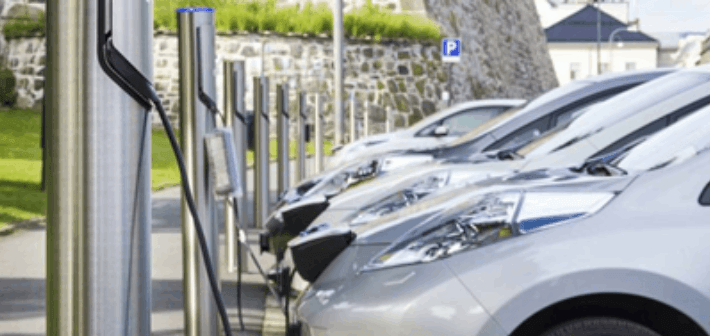
Velasco Mobility Plan
As the primary approach and entrance to the site, Velasco Street will be designed with pedestrian mobility in mind. Safe, comfortable sidewalks along the street, with a minimum right-of-way given to vehicular traffic to encourage slower speed, will be accompanied by street trees that provide shade to pedestrians, as well as forming an additional buffer between the pedestrian and vehicular realms. The portion of the street that sits directly in front of the site may also be temporary closed from time to time to accommodate large gatherings such as farmers markets and cultural festivals.
The site has been designed in such a way as to give ample public space between the buildings and the street, forming a condition like that of a linear park. This elongated plaza will provide continuity throughout the complex, while provided an uninterrupted, landscaped route (in addition to the mentioned sidewalks) from the transit hub at the south end of the site to the bike hub and amphitheater to the north. With specific amenities located throughout (such as community gardens, boardwalks, fountains and bicycle storage and repair), this zone can be used for specific, individual functions or large public gatherings or events for residents and workers.
Integration with the existing hike/bike trail along Buffalo Bayou expands access from other areas of the neighborhood and encourages pedestrian movement to and from the site, including to surrounding neighborhoods. By creating a monumental trail marker at this intersection, the design hopes to capture the attention of passersby and draw them into the site, while creating a destination for those entering the site from the south.
The site has been designed in such a way as to give ample public space between the buildings and the street, forming a condition like that of a linear park. This elongated plaza will provide continuity throughout the complex, while provided an uninterrupted, landscaped route (in addition to the mentioned sidewalks) from the transit hub at the south end of the site to the bike hub and amphitheater to the north. With specific amenities located throughout (such as community gardens, boardwalks, fountains and bicycle storage and repair), this zone can be used for specific, individual functions or large public gatherings or events for residents and workers.
Integration with the existing hike/bike trail along Buffalo Bayou expands access from other areas of the neighborhood and encourages pedestrian movement to and from the site, including to surrounding neighborhoods. By creating a monumental trail marker at this intersection, the design hopes to capture the attention of passersby and draw them into the site, while creating a destination for those entering the site from the south.
A stakeholder engagement manager will be designated for the site to manage relationships with appropriate stakeholders, community members, residents, and employees of the site. This individual will work with local partners and the City of Houston to link Buffalo Bayou Trail and the proposed network of sidewalks, bike paths, and METRO stops with Navigation Blvd., resulting in a fully integrated low-carbon transport network.
By extending Velasco St. to Buffalo Bayou and incorporating a bike path alongside, the site has direct access to the adjacent hike/bike trail that runs along the bayou. This runs west to Downtown and beyond, and east to Marron Park. Between the existing trail and the proposed bikeway along nearby Navigation Blvd., the project site would have a high level of access to bikeways connecting regional parks, dense residential areas, and nearby commercial and industrial centers. A protected bike lane, formed by cars parallel parked 8 ft from the curb, will be included on Velasco St. to allow safe access to cyclists. A similar design has been implemented in New York City with significant success and is being constructed at various locations around Houston at the time of this proposal.

To further incentivize cycling, a bike hub at the north end of the site will form a transition point from the recreational bayou trail to the Innovation Center and local street system. This hub would feature onsite bike storage for 360 bicycles and repair facilities, showers for cycling commuters, and a shared bike center through an external partner. These facilities will be subsidized for residents and employees, and access will be granted through their site access keys. Using the keys as trackers, usage statistics for the bike hub can be monitored. Furthermore, counting trackers along the surrounding bike paths on the site will allow for accurate measurements on the use of these trails by the community. Periodic stakeholder engagement sessions with the community with the data collected at the site will create an opportunity for feedback and appropriate changes will be implemented to maximize convenient use of this service.
Much like the transit hub at the south end of the site, this space will also serve as a safe area for visitors to sit or to rest and can act as a literal and figurative gateway to the site. The chosen site sits ¼ mile away from bus stops that serve two local routes, and ½ mile from a light rail station that connects the area to Houston’s central business district. Street design along Velasco St. and the inclusion of a linear park would ensure safe, comfortable, shaded access between Navigation Blvd. and the Innovation Center, and owners could work with neighborhood organizations and city planners to extend this pedestrian friendly design to include a wider radius of transit stops.

A transportation hub located at the entrance to the site provides a comfortable, safe waiting area for users of public transit and accessible transit systems and shuttles (such as METROLift) and could be used as a convenient ride-share drop-off point in lieu of additional parking spaces. The appointed Stakeholder Engagement Manager will work to partner with METRO to negotiate subsidized passes for site residents and employees for local travel. Usage statistics from this program with transit-tracking technology will provide actionable insights to maximize use of these amenities and reduce single-rides vehicles. Finally, advanced connected messaging systems will provide user-friendly updates on imminent arrivals (buses, METRO, possibly rideshare) and can be easily adapted to accommodate driverless-automobile technology should it become prevalent.
The function of the building itself, with the provision of collaborative lab and office spaces, serves to encourage and to develop low-carbon alternatives not only for transportation, but various industry applications dependent on fossil fuels. The limited onsite parking supplemented by street parking along Velasco St. will be fitted with electric and H2 charging stations. These stations would utilize locally generated electricity, when possible, to supply power. Access to electric vehicles would also be provided through Zipcar availability.

In its current state, Velasco St. will need significant improvements for it to serve as a viable route to access the project site. The design team recommends taking this opportunity to design a street that provides primary convenience to public transportation, cyclists, pedestrians, and ride-share and discouraging passenger car use, while meeting city requirements for service and emergency access. A wide, well-lit sidewalk and a protected bike lane will be introduced along Velasco St., and street parking will be paid. Subsidized rates will be considered for low/no carbon vehicles.
